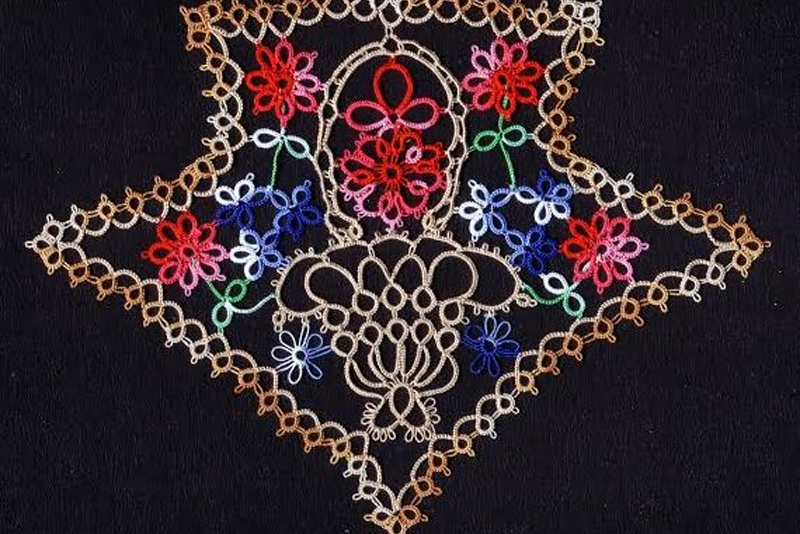We all become a little bit Irish on St. Patrick's Day and shamrocks are a welcome sign of spring as well. To me the shamrock is a memory of a special tatting moment.
Back in 1980 I had only been tatting a year and I carried it with me everywhere. One day at the laundromat in Sacramento CA I pulled out my shuttle to tat while I waited for the wash to run through the cycle. I soon noticed a rather elderly lady watching me and we struck up a conversation when she pulled out a shuttle too! She asked me if I knew the pattern, "9, 11, 13 make a shamrock green?" And she proceeded to teach me this shamrock pattern.
Patterns were mostly limited to the Workbasket and vintage 10-cent booklets back then. Rebecca Jones' "The Complete Book of Tatting" was not in print yet and Mary Konior's books had not been imported to the USA even. I was all curious to find out what book the shamrock was in and so I asked. The lady just smiled and said she had learned the pattern from Priscilla.
Many of you are probably smiling by now, and, yes, it is true, I was so new to tatting I did not even know about the Modern Priscilla needlework magazines from the early 1900's. Some time later I started collecting the tatting patterns from those magazines and today I try to share the modernized, rewritten and diagrammed patterns with other tatters.
But there is more to the story. I was introduced to Angeline Crichlow by another tatting historian, Mary Lou Tiffany. Angeline lived in Sacramento. Her bicentennial project for 1976 was to write a tatting book, "Let's Tat!" Angeline went on to write more books and I believe she pioneered tatting in 3-dimensions and made many toys in tatting. We corresponded for years. Some where along the line I found out that she lived 3 blocks from that laundromat! Was it Angeline who tatted with me? I will always think so.
|
The Shamrock Pattern: R 11 picots separated by 3 DS cl ring. Leave ½" space. Do not rw R 13 picots separated by 3 DS cl ring. Leave ½" space. Do not rw R 11 picots separated by 3 DS cl ring. Leave ½" space. Rotate to position to chain. |
 |
 |
Work the next rows all in chainwork around the outside of the rings attaching chains to the center picot of each ring and the two spaces in between rings.
CH 9 picots separated by 2 DS Attach to ring with the shuttle join. Repeat, attaching space between rings. CH 11 picots separated by 2 DS. Attach to ring with the shuttle join. Repeat, attaching to space between rings. CH 9 picots separated by 2 DS. Attach to ring with the shuttle join. Repeat attaching to space between rings. Do not turn. Do not cut thread.
Second row of chain work:
CH 11 picots separated by 3 DS. Attach to ring with the shuttle join. Repeat, attaching to space between rings. CH 13 picots separated by 3 DS. Attach to ring with the shuttle join. Repeat, attaching to space between rings. CH 11 picots separated by 3 DS. Attach to ring with the shuttle join. Repeat, attaching to space between rings. Stem: After attaching last chain segment continue to chain approx 2". Make a small picot, chain 6 DS and join back into that picot. Tie and cut. Whipstitch or glue or hide ends properly in back.
Here's the latest article from the Tatting site at BellaOnline.com.
Building a Tatting Library - Anne Orr
A tatting reference library is a wonderful resource for all tatters. Start building your own reference library by acquiring the most influential books of the 20th century.
http://www.bellaonline.com/articles/art70463.asp
Please visit tatting.bellaonline.com for even more great content about Tatting.
To participate in free, fun online discussions, this site has a community forum all about Tatting located here -
http://forums.bellaonline.com/ubbthreads.php?ubb=postlist&Board=39
I hope to hear from you sometime soon, either in the forum or in response to this email message. I thrive on your feedback!
Have fun passing this message along to family and friends, because we all love free knowledge!
Georgia Seitz, Tatting Editor
http://tatting.bellaonline.com
One of hundreds of sites at BellaOnline.com







